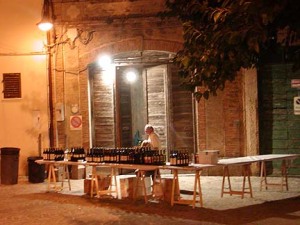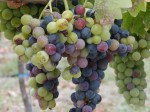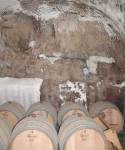 Calici di Stelle — Chalices of Stars — now in its 14th year is fast becoming a wine tasting tradition in Italy. In most localities it is held on August 10. That’s the “official” date for the most abundant period of the Perseids meteor shower.
Calici di Stelle — Chalices of Stars — now in its 14th year is fast becoming a wine tasting tradition in Italy. In most localities it is held on August 10. That’s the “official” date for the most abundant period of the Perseids meteor shower.
The date itself is legendary throughout Italy as the feast day of San Lorenzo. They say the stars that “fall” on La Notte di San Lorenzo are the saint’s tears. Other legends tell us that they are tears shed at his burial, or, in the Veneto, the burning charcoal from his martyrdom falling from the sky.
San Lorenzo
 San Lorenzo purportedly spirited away the Holy Grail for safe keeping in his youth. Later, in 258 AD, he was martyred when he presented Rome’s poor and sick instead of gold and silver to the prefect who had demanded of Lorenzo all the church’s treasures. Sentenced to being slow-roasted alive on a grill, it is said that he joked “I am done on this side — turn me over,” earning him the honor of being designated the patron saint of cooks and chefs. So, in a dark way, it seems entirely appropriate that the 300 Italian cities in the association Città del Vino will have as their focus Wednesday night their regional wine and food.
San Lorenzo purportedly spirited away the Holy Grail for safe keeping in his youth. Later, in 258 AD, he was martyred when he presented Rome’s poor and sick instead of gold and silver to the prefect who had demanded of Lorenzo all the church’s treasures. Sentenced to being slow-roasted alive on a grill, it is said that he joked “I am done on this side — turn me over,” earning him the honor of being designated the patron saint of cooks and chefs. So, in a dark way, it seems entirely appropriate that the 300 Italian cities in the association Città del Vino will have as their focus Wednesday night their regional wine and food.
Morro d’Alba
In 2005 we were fortunate enough to quite literally stumble upon the Calici di Stelle celebration in Morro d’Alba, a small Le Marche hilltown of less than 2,000 people that is the center of the small growing region for the indigenous Lacrima di Morro d’Alba grape. We had come to Italy for the summer looking for traditionally styled wine to import back to the states, and were tasting our way up the Adriatic coast before moving inland to Matelica and ultimately Umbria. That we were in Morro d’Alba on August 10 was pure kismet.
The castle that topped the medieval walls of the city had been transformed that evening from cold stone into a warm and fuzzy venue. In exchange for a few euros we were given a glass, a plate, and free rein to start grazing.  Tables of locally produced bread, sausage, cheese, honey, and wine lined la scarpa, the stone portico surrounding the castle. The sound of music drifting through the passageway finally drew us inside to the piazza where a sound system pumped out a somewhat tinny delivery of classical music. Children played in the adjacent park while their parents and grandparents talked and ate at the carefully arranged tables. The music of their conversation — their chiacchierare — blended perfectly with the piped music and the liquid music in my glass. Finally, reluctantly, I turned back to the passageway. I gazed through the arrow slits and across the valleys below dotted here and there with farm lights, and at the thin glowing line on the horizon that separated the heavens from the Adriatic. Looking up, I saw the stars of San Lorenzo begin to silently zip across the sky.
Tables of locally produced bread, sausage, cheese, honey, and wine lined la scarpa, the stone portico surrounding the castle. The sound of music drifting through the passageway finally drew us inside to the piazza where a sound system pumped out a somewhat tinny delivery of classical music. Children played in the adjacent park while their parents and grandparents talked and ate at the carefully arranged tables. The music of their conversation — their chiacchierare — blended perfectly with the piped music and the liquid music in my glass. Finally, reluctantly, I turned back to the passageway. I gazed through the arrow slits and across the valleys below dotted here and there with farm lights, and at the thin glowing line on the horizon that separated the heavens from the Adriatic. Looking up, I saw the stars of San Lorenzo begin to silently zip across the sky.
Cin-cin!

Morro d’Alba holds its Calici di Stelle again tomorrow night. Also, the new Cesanese del Piglio DOCG region will host its first Calici di Stelle followed by two more days of walking wine tasting through the old town of Serrone, music, and even a five-day horse trip through the countryside following ancient sheepherding trails. They definitely know how to party in Serrone!
It’s too late for me to hop a plane to Italy in time for Calici di Stelle this year. But I’ll be there in heart and spirit. I’ll raise a toast to the east as the stars start to fall here in Northern California. Cin-cin! Nazzereno, Vico, and Valentina Vicari; Cin-cin! Vittorio and Mirto Badiali in Morro d’Alba. Cin-cin! Giovanni and Armando Terenzi in Piglio. Cin-cin! to all the Italian producers who continue to protect the heritage grapes of their regions.
P.S. The astronomical event is the catalyst for a brilliant Italian movie that uses the dreaminess of the night-time spectacle to launch a semi-autobiographical tale of the struggles of a World War II Tuscan village and the toll the war took on neighbors and family. Paolo and Vittorio Taviani’s 1982 darkly comedic romp through modern Italian history, La Notte di San Lorenzo (The Night of the Shooting Stars) is now on DVD from amazon.com: http://amzn.to/o3K85P




